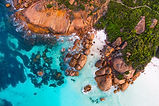Geography
The country of Guatemala is located in Central America, South ofMexico and north of Honduras. Guatemala is also bordered, to the northeast by Belize and the Gulf of Honduras,, to the southeast by El Salvador, and to the south by the Pacific Ocean. Located within the tropics and with elevations ranging between sea level and more than 13,000 feet, Guatemala experiences a diversity of climates. Below 3,000 feet in elevation, average temperatures range between 70 and 80 °Fahrenheit throughout the year; between 3,000 and 5,000 feet temperatures range between 60 and 70 °F; and from 6,000 to 9,000 feet they range between 50 and 60 °F. In the south of Guatemala there is a massive string of 27 volcanoes with fertile plains separating it from the Pacific Ocean. The Petén region, a large, low-lying area just north, takes up a portion of the Yucatán Peninsula, a limestone platform it shares with Mexico and Belize. Between the volcanic landscape and the Petén are the high mountain ranges and valleys.The volcanic region of Guatemala is made of three elements: a row of volcanoes, flanked by a deeply eroded volcanic tableland of older origin to the north and the narrow coastal plain constructed of volcanic debris on the Pacific slope. The Pacific coastal plain gradually slopes south to sea level at the shoreline of the ocean. The plain extends east-west for about 150 miles (240 km) and is one of the country’s richest agricultural areas. Three-fourths of the population and most of the major cities are concentrated in the volcanic region and the Pacific slope. Guatemala is defined by tropical climates, limestone quarries, and a powerful ring of active volcanoes with various landscapes and climates.




